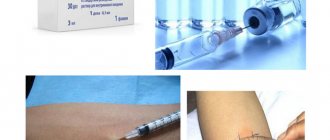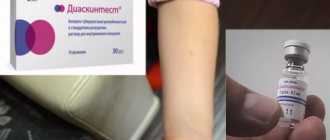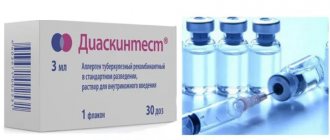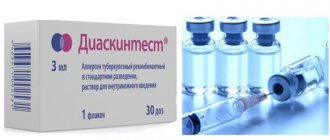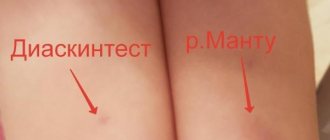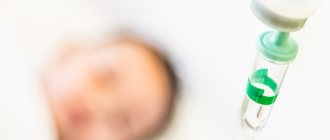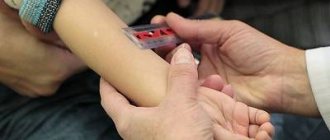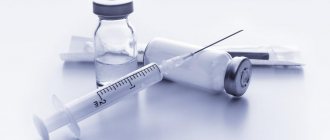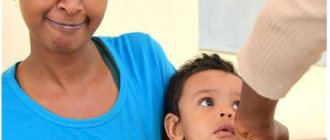Diaskintest is one of the methods for diagnosing tuberculosis. Tuberculin diagnostics is constantly being improved. This is important because tuberculosis is a disease that is widespread in many countries.
Both children and adults suffer from tuberculosis. To diagnose and determine the prognosis of the disease, it is important to assess the strength of the immune system in relation to the causative agent of the disease.
The first method of detecting immunity was the Pirquet test, then it was replaced by the Mantoux test. At the moment, Diaskintest is the most popular.
The next generation of tuberculosis diagnostic methods was the generation of IGRA tests. These include the quantiferon test. The material about this test contains a comparison table for all diagnostic methods.
Diaskintest - what is it
For reference. Diaskintest is a drug used to test for immunity to Mycobacterium tuberculosis.
The short name of the drug is also used - Diaskin. The test itself with this drug is also called Diaskintest. The drug is a diagnosticum that contains two antigens that are part of Mycobacterium tuberculosis. Based on these antigens, the human immune system recognizes Koch bacilli and starts the process of their destruction.
For reference. In order for Diaskin to be a pure preparation, without foreign impurities, antigens are specially grown. To do this, the genetic material of Mycobacterium tuberculosis is introduced into the colonies of non-pathogenic bacteria of the human body - Escherichia coli.
E. coli begin to express antigens characteristic of mycobacteria. For the diagnostic test, only two antigens were selected, found in “wild” strains of Koch bacilli, which cause the disease.
A protein extract is prepared from colonies of E. coli. In this case, only two antigens inherent specifically to tuberculous mycobacteria are removed. The diagnosticum is placed in bottles in such a way that 0.1 ml contains one diagnostic dose of antigens.
Result reliability indicators
For reference. Any laboratory research method has two main indicators of reliability: sensitivity and specificity. Both indicators are intensive, that is, they are calculated per 100 people who were tested.
The sensitivity indicator gives an idea of how many people who are immune to mycobacterium tuberculosis will have a negative diaskintest. These are the so-called “false negative results”.
For Diaskintest, the maximum number of such results is 12 per 100 samples. These people will have a negative test, despite the presence of immunity.
For reference. False negative results occur in cases where the immune response was insufficient to cause a reaction to the administered diagnosticum.
The specificity indicator gives an idea of how many people who do not have immunity to Mycobacterium tuberculosis will have a positive diaskintest. These are the so-called “false positive” values.
The maximum number for Diaskintest is 2 per 100 samples. They arise due to the fact that some microorganisms have antigens similar to those of the Koch bacillus. Diaskintest rarely recognizes them as tuberculosis, but sometimes such errors occur.
For reference. The sensitivity and specificity indicators of Diaskintest are better than those of the Mantoux test. This indicates the greater reliability of the method in comparison with other methods of laboratory diagnostics.
Purpose of Diaskintest
Attention. The only purpose of Diaskintest is to determine the presence or absence of immunity to Mycobacterium tuberculosis. This method does not diagnose active tuberculosis. This statement is especially true for adults and children who have previously been in contact with Mycobacterium tuberculosis.
The fact is that when it first enters the body, the Koch bacillus causes primary tuberculosis. In the vast majority of children, and the first contact occurs precisely in childhood, primary tuberculosis is asymptomatic or has a flu-like course.
Despite the mild course of the disease, the body reacts to mycobacteria as it does to any other infectious agent. At the same time, specific immune cells are produced - T-lymphocytes. They prevent Koch bacilli from spreading throughout the body and protect a person from re-infection.
For reference. T lymphocytes trained to recognize and destroy Koch bacilli remain in the body for life. At the same time, mycobacteria that are in the area of the primary focus in an inactive state can remain in the body for life. This process is called non-sterile immunity.
The purpose of diaskintest is to identify T-lymphocytes that appear upon contact with mycobacteria.
The principle of action of the drug is very simple - an antigen (also known as an allergen), which is contained in Mycobacterium tuberculosis, is injected intradermally. If there is an inflammatory reaction at the injection site, then the immune system has reacted to tuberculin.
If you react, it means you have immunity to Koch bacilli, the T-lymphocytes have already been trained, and the primary infection has already occurred. This information is most relevant for children.
Diaskintest is performed for adults if they have active tuberculosis. If immunity is intact, there should be no secondary infection.
If a person gets sick with tuberculosis again, it means his immunity has not coped with its task. This can be a consequence of immunodeficiency or infection with overly aggressive strains of tuberculosis.
For reference. At the same time, diaskintest is necessary in order to understand whether this patient has immunity to mycobacteria and how much it is reduced. Lack of immunity is a poor prognostic sign.
Compound
It is worth immediately noting that the drug does not contain either live tuberculosis bacteria or their metabolic products.
The composition contains only antigens of synthetic origin, which, when they enter the human body, are recognized by the immune system as pathogens of the disease.
The diagnostic preparation also contains auxiliary components: saline solution, phenol, polysorbate, potassium phosphate and sodium. All these substances are included in the composition in small quantities and do not have a negative effect on the body.
Indications and contraindications for the procedure
Diaskintest at school is carried out regularly for all children once a year. Regardless of whether a child has signs of tuberculosis or not, he should be diagnosed.
For reference. This is done in order to identify the turn of the tuberculin test - the moment of infection with Mycobacterium tuberculosis. In this case, there are no indications for the test; it is simply a planned mandatory procedure.
This is done in those countries where Diaskintest has replaced the Mantoux test, including the Russian Federation.
In some cases, there is a need for an unscheduled diaskintest. In children, indications for it are:
- prolonged persistent cough;
- prolonged low-grade fever;
- symptoms of pneumonia in the absence of effect from broad-spectrum antibiotics;
- contact with a patient with tuberculosis (being in an epidemic focus).
Thus, the indication for performing a diaskintest is a suspicion of infection with Mycobacterium tuberculosis. In addition, in those countries where the Mantoux test is still used, Diaskintest is necessary for differential diagnosis between a post-vaccination reaction and primary tuberculosis.
The fact is that Mantoux can be positive both after administration of the BCG vaccine and during infection with mycobacteria. Diaskintest reacts only to “wild” strains.
For reference. If the Mantoux test is positive and the Diaskintest is negative, then the child remains immune after the vaccine.
In adults, it is impossible to detect active tuberculosis using Diaskintest. The result should normally be positive, since all adults in epidemically unfavorable regions are infected with Koch bacilli.
Diaskintest has rather a prognostic value. So, if a patient is diagnosed with tuberculosis and there is a violent reaction to the test, the prognosis is favorable. This means that the immune system has mobilized its forces to fight this infection.
For reference. If tuberculosis is present, but the reaction is weak or absent, then the prognosis is unfavorable. This means that the immune system is suppressed and the body itself cannot cope with the infection.
This rule does not apply to adults who come from epidemic-friendly areas. They may not have immunity to mycobacteria due to lack of contact with sick people.
Attention. In adults, Diaskintest is necessarily used in combination with other methods of diagnosing tuberculosis and is not the primary method.
There are a number of contraindications, in the presence of which Diaskintest is not performed either planned or urgently according to indications.
What you can and cannot eat after vaccination
After the Diaskintest injection, strict rules regarding the choice of food are not established. You can eat and drink everything that is usually included in the menu. You shouldn’t limit yourself; you can eat sweets and enjoy your favorite foods. Although, of course, you shouldn’t eat desserts alone either. A reasonable approach to nutrition after an injection is to exclude foods that can trigger an allergic reaction. In addition, foods that are highly allergenic should be removed from the child’s diet:
- oranges, tangerines and other citrus fruits;
- chocolate;
- red apples;
- nuts.

You should not feed your baby new exotic foods; they can cause an unpredictable reaction. The menu should remain the same as the child is accustomed to.
Other restrictions
Doctors do not recommend actively engaging in sports after Diaskintest, because increased physical activity causes profuse sweating, and sweat is an irritating factor that can cause a skin reaction in the form of redness and itching. The result in this case may be false positive.
After Diaskintest, you should not expose your body to sudden temperature changes: take long walks in the cold in winter or stay in the sun for a long time in summer. All this can have a distorting effect and lead to “blurred” results.
It is better to give up alcohol within 72 hours, as alcohol can change the severity of the reaction, and the result may also be false.
Frequency of Diaskintest
For reference. Healthy children are supposed to undergo Diaskintest once a year. This is provided that they have received vaccination.
The BCG vaccine is administered to a child at birth and at the age of seven. Vaccinated children are protected against Mycobacterium tuberculosis for several years after the vaccine is administered.
However, there are categories of children who were not given the BCG vaccine for various reasons. Such children are more likely to develop tuberculosis, and the risk of a severe course of the disease is high. For this category of children, Diaskintest is carried out twice a year as planned.
For adults, Diaskintest is not a mandatory screening method. It is important for this population group to undergo fluorographic examination once a year.
Diaskintest is carried out exclusively according to indications when an active form of tuberculosis is suspected.
For reference. If necessary, Diaskintest can be used an unlimited number of times. In this case, you should alternate between the right and left hands and avoid inserting into the same place. It is recommended to repeat the test no more than once every 2-3 months due to the risk of local allergies.
Frequently asked questions to the doctor
Since Diaskintest has been used relatively recently, parents of young patients have many questions about the diagnostic test. Let's look at the most common of them:
- At what age is Diaskintest allowed?
The manufacturer notes the possibility of using intradermal testing in all age groups and indicates the absence of any age restrictions.
According to the clinical recommendations of Russian healthcare, all children from one to 7 years old are recommended to undergo an annual Mantoux test. If a child has not been vaccinated with BCG, a diagnostic test is carried out 2 times a year, starting from 6 months, until vaccination against tuberculosis.
If a child under 7 years of age has a positive reaction to the Mantoux test, a phthisiatrician may recommend additional use of Diaskintest. After the child reaches the age of 8 and up to 17, Diaskintest is indicated every year.
- Is it possible to do both diagnostic tests on the same day?
If a phthisiatrician has doubts about the reliability of the Mantoux test, the doctor may recommend doing both reactions. Experts allow the simultaneous performance of the Mantoux and Diaskintest tests, provided that tests are performed on different hands.
- Is it dangerous for water to get into the sample location?
Everyone has heard that you shouldn’t wet the Mantoux sample, but what about Diaskintest? Although water, in most cases, does not have any negative effect and does not affect the results of both tests, it is still worth exercising caution.
Swimming in the pool, actively washing hands with detergents, using a patch can cause irritation and itching, and then a nonspecific allergy. In this case, it will not be possible to correctly evaluate the result. Therefore, doctors recommend that parents be attentive to their children, do not allow them to scratch the injection site and do not use products that cause irritation and allergies.
- Is it possible to combine the Diaskintest test and vaccinations?
The diagnostic test needs to be assessed before the next vaccination is administered, so it is better to first carry out the diagnosis and then vaccinate according to the calendar. If your baby has recently been vaccinated, you need to postpone the diagnosis of tuberculosis for a month. After this period, it is worth carrying out Diaskintest, then its results will be reliable.
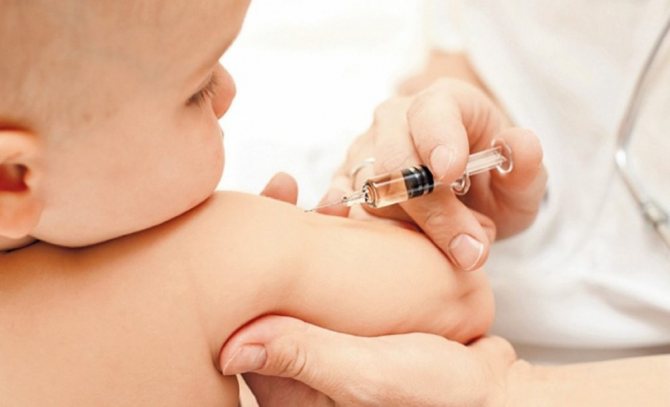
- What to do if it’s time to do the test, and the baby gets sick?
If a child has signs of acute respiratory viral infection, it is recommended to postpone the test until the baby has completely recovered. In the event of an exacerbation of a chronic disease in a baby, you should first take care of the child’s health and then use Diaskintest.
If a child is prone to allergic reactions, you need to prepare in advance for the test - give the baby desensitizing drugs 5 days before the test and 2 days after it. If a child is registered with an allergist, for example, with bronchial asthma, it is necessary to consult a doctor before making a diagnosis.
- Is it allowed to test a child in a clinic if the kindergarten is closed for quarantine?
If an infectious disease is detected in a preschool institution, quarantine measures must be taken. Even if the baby looks healthy, you need to wait until the end of the forced break and then conduct a test.
- Is it worth sticking to a diet while being diagnosed with tuberculosis?
The manufacturer of the drug does not indicate the need to limit any foods when administering Diaskintest. Doctors advise not to eat food that can provoke allergic reactions in a child. It is necessary to avoid any contact with potentially hazardous substances, not only in products, but also in the environment. This is especially true for children prone to hypersensitivity.
- Is it safe to use Diaskintest in pediatric practice?
If the drug is administered correctly and the correct dosage is observed, the test does not have a negative effect on the baby’s health. Parents should understand that Diaskintest, like any antigen, can cause general reactions in the form of weakness, headache, fever. But such manifestations occur in rare cases and do not cause harm to the body.
- What should the test result be for a healthy person?
The reaction to Diaskintest should be negative, regardless of the age and the fact of immunization of the child. With Mantoux, things are different - a baby who has not yet been vaccinated with BCG must have a negative tuberculin test. After vaccination, the reaction becomes weakly positive or positive, which indicates the formation of immunity against tuberculosis.
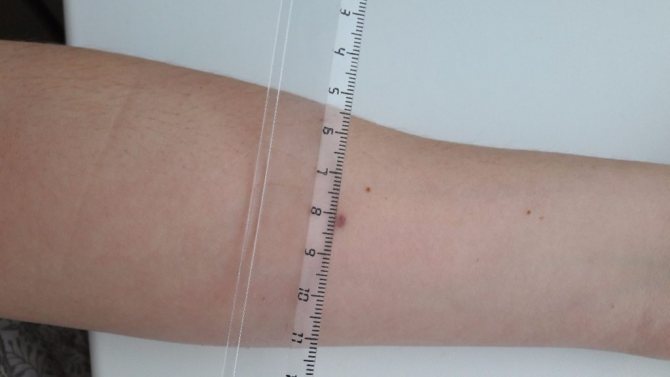
An increase in papule from the Mantoux test can occur immediately after BCG and is considered a post-vaccination reaction. If several years have passed after the vaccination, and the test result has changed dramatically, the baby requires additional examination, testing and chest x-rays.
- Is it possible to prescribe preventive treatment against tuberculosis based on diagnostic tests?
With the advent of a new diagnostic test, the number of unjustifiably prescribed treatments has decreased. Children with a positive Mantoux test and a negative Diaskintest are absolutely healthy, and their immunity works.
Massive use of anti-tuberculosis drugs leads to increased resistance of mycobacteria and the development of especially dangerous forms of the disease. A TB doctor should prescribe preventive treatment after a thorough laboratory and instrumental examination of the child.
Side effects of Diaskintest
Only rare cases of side effects are known. Their low frequency and low risk of occurrence are associated with the method of drug administration.
The test is carried out intradermally, so the substance does not enter the systemic bloodstream.
For reference. The most common side effect is a nonspecific allergic reaction at the injection site. Allergy is associated with individual intolerance to the components of the drug.
In rare cases, side effects may occur such as:
- headache,
- low-grade fever,
- increased blood pressure,
- increased fatigue.
Even less common are local manifestations in the form of subcutaneous hematomas or pustules. As a rule, adverse reactions are associated with a violation of the test technique. For example, they can occur if an allergic history is not collected, the skin is incorrectly treated with an antiseptic, or the nurse gives a subcutaneous injection instead of an intradermal one, and the drug gets into the blood.
Is Diaskintest dangerous?
There are several myths associated with tuberculin diagnostics. The most unfounded and frightening of them is the danger of contracting tuberculosis due to the administration of the drug. In fact, this is impossible even if the injection technique was violated.
The fact is that Diaskintest is a sterile drug. It contains absolutely no microorganisms.
For reference. In order for an immune reaction to occur, the introduction of mycobacterial antigen proteins is sufficient. In this case, the tuberculosis bacilli themselves are not needed. The drug contains only two antigens, which by themselves cannot cause disease.
Moreover, Diaskintest is administered intradermally. All drugs with this method of administration do not enter the bloodstream. This means that Diaskintest can only cause a local reaction.
The only danger in this case is the occurrence of a nonspecific allergy to a foreign protein. But, as a rule, it is local in nature and does not pose a threat to the body.
How do you feel about mandatory vaccination?
- Positively, it prevents many diseases. 60%, 2641 votes
2641 votes 60%2641 votes - 60% of all votes
- Negatively, these are all government schemes to make it easier to manage us. 26%, 1157 votes
1157 votes 26%
1157 votes - 26% of all votes
- Neutral, I don’t think it has any effect on my health. 13%, 592 votes
592 votes 13%
592 votes - 13% of all votes
Total votes: 4390
Votes: 4365
January 17, 2018
×
You or from your IP have already voted.
Which is better - mantu or diaskintest
For reference. At the moment, there are two main methods for determining immunity to tuberculosis using antigen diagnostics - Diaskintest and Mantoux test. Each of them has its positive and negative sides.
The Mantoux test is performed using a protein extract made from several strains of mycobacteria. The drug used for the test contains proteins that are present in both “wild” and vaccine strains.
The Mantoux test causes an immune reaction both during infection with tuberculosis and after the BCG vaccine. In addition, it may react to the presence of other mycobacteria that do not cause tuberculosis.
Thus, the Mantoux test has less specificity than the Diaskintest. When performing it, it is difficult to distinguish post-vaccination immunity from that acquired during primary tuberculosis. These are the main disadvantages of the Mantoux test.
For reference. Diaskintest is made by growing strains of bacteria that express only two Koch bacilli antigens.
These antigens are found in “wild” strains, but are absent in vaccine strains. Diaskintest causes an immune reaction only in those infected with tuberculosis.
There are no post-vaccination reactions, no cross-reactions with other mycobacteria. All these are the benefits of Diaskin.
The disadvantage is that the antigens of this test do not appear immediately after infection with tuberculosis. That is, when a primary outbreak occurs, the Mantoux test will respond faster than the Diaskintest.
In many countries, Diaskintest is used as the first-line method for diagnosing primary tuberculosis.
Attention. However, it is worth remembering that this method does not recognize immunity that occurs immediately after infection. In addition, the Mantoux test is still used to determine the strength of immunity after the BCG vaccine, which Diaskintest cannot do.
Preparation for the procedure
Diaskintest is a procedure that can almost always be performed without any specific preparation.
Exceptions include several categories of the population.
Attention. First of all, people who suffer from allergies deserve special attention. At least a week before the test, they need to start taking antihistamines in regular dosages.
This will not affect the test result, but will prevent the development of an allergic reaction. If your child has seasonal allergies, the routine test should be postponed until winter.
Another category of children who need to select the time of administration of the test according to the calendar are children who have reached the age of vaccination.
Attention. Regardless of what vaccination the child is given, Diaskintest cannot be performed for another month after it. If a child is vaccinated with BCG, Diaskintest cannot be administered less than a month before and earlier than a month after vaccination.
Adults should not drink any alcoholic beverages less than 72 hours before the test. In addition, you should avoid alcohol until the test results are assessed.
Before carrying out the Diaskintest, it is necessary to carry out thermometry. If the result of thermometry is not explained by the possible presence of tuberculosis and an acute respiratory infection cannot be excluded, the diaskintest should be postponed until recovery.
Traces from the sample
The patient needs to properly care for the skin at the injection site.
If the papule begins to itch, it should not be wetted with water, heated, rubbed or cooled. On the first day after the test, the child notices a change in the color of the spot, which acquires a bluish tint. If with Diaskintest the patient does not feel discomfort at the injection site, there is no need to worry. With Diaskintest, sometimes a large red spot appears after the injection. After a few hours, the skin at the injection site begins to itch painfully, and the spot spreads to the forearm and face.
An allergic reaction is accompanied by fever, weakness, and malaise. In severe cases, the injection site is very painful, there is a burning sensation and itching. On the second day, if the body reacts negatively to the introduction of the antigen, a small puncture point remains on the skin.
On the second day, the resorption of a small hematoma begins after injury to the blood vessels. If the child’s condition worsens or atypical symptoms appear, you should immediately consult a doctor.
On the third day, the final results of the test are summed up. The injection leaves a barely noticeable mark on the skin of a healthy child.
Which institutions conduct Diaskintest?
Diaskintest is carried out for healthy children in preschool institutions, schools, boarding schools, orphanages, and infant homes. All children attending organized children's groups undergo the procedure according to the preventive examination schedule.
For reference. Diaskintest is performed by specially trained medical personnel in manipulation rooms or a nurse’s office in an institution.
If the child does not attend the listed institutions or missed a general examination, the parents should take him to the local clinic to see the local pediatrician.
Algorithm for conducting diaskintest
The diagnosticum is administered by a specially trained nurse in the manipulation room. She sequentially performs the following actions:
- Checks the bottle with the drug for leaks, expiration date, evaluates the type of contents;
- Draws 0.2 ml of the drug from the bottle into a tuberculin syringe;
- Wipes the palmar surface of the middle third of the forearm with alcohol for antiseptic purposes;
- Injects 0.1 ml of the drug from a syringe into the middle third of the forearm strictly intradermally.
After this, the test itself is completed.
Attention. Results are assessed after 72 hours. The patient’s task is to protect the injection site from friction, contamination and chemicals for three days.
Is it possible to wet Diaskintest?
There is a myth that Diaskintest, like the Mantoux test, cannot be wetted with water.
In fact, after both tests, the papules do not react to water in any way. You can wet them with plain water, you can also take a shower. The main thing is to avoid friction, contact with soap, shower gels, creams and any other chemicals.
Attention. Before assessing the test result, you should not take a bath to avoid interaction with chemicals contained in the water.
You should also avoid visiting the sauna and swimming pool. If chemicals come into contact with the papule or if it is rubbed excessively, nonspecific inflammation may occur. The latter may be mistakenly regarded as a positive reaction to the diagnosticum.
Positive Diaskintest and subsequent actions
If the result is positive or even questionable, the doctor will send you for additional tests. They may send your loved ones with whom you have had recent contact for tests, especially if there are children among them. To determine the cause of the disease, the doctor will need to know the true conditions of your residence, which most often turns out to be the causative agent of the infection.
You can get sick not only because of poor living conditions, but also because of smoking, poor and untimely nutrition, and a decline in the immune system. There are many more reasons why you can get sick. There are cases when a person who follows a healthy lifestyle becomes ill with tuberculosis.
After the test and receiving a positive result, a person must contact a phthisiatrician who will conduct an examination and prescribe treatment. If tuberculosis is at an early stage, it can be cured completely. Modern medications and therapy make it possible to cope with the disease in a short time. There are cases when even after treatment Diaskintest shows a positive reaction. This may mean that the disease is not completely cured or is resistant to the medications used during treatment.
Tuberculosis is quite difficult to treat, because the disease develops resistance to certain drugs. It is not possible to use the same remedy during treatment, which affects the recovery time. This means that the doctor needs to select several treatment options for rapid treatment.
Many people sometimes ignore tuberculosis, believing that it will not affect them because of a healthy lifestyle and good living conditions. But Diaskintest is now available in almost every medical institution. This test is considered accurate and truthful, as it does not react to other pathogens. If the test result is positive, the person is most likely infected and needs to see a doctor. You should not be afraid of the disease; you need to find out the cause, diagnose it and begin treatment. In most cases, people overcome the disease and feel great.
Diaskintest results
A reliable result can be obtained no earlier than 72 hours after the test.
To do this, carefully study the injection site of the drug. There may simply be an injection mark, a papule of different sizes, a vesicle or other elements. They can be located on a hyperemic or non-hyperemic background.
The diameter of all found morphological elements is measured with a ruler. The data is entered into an outpatient card or other medical document.
Possible results
The reaction to Diaskintest may vary. There are three main results of Diaskin:
- Negative - there are no traces at the site of drug administration, except for the mark of a syringe injection;
- Doubtful - there is slight redness around the injection site, level with the skin;
- Positive - at the injection site there are elements rising above the surface of the skin.
For reference. A positive result means that the body has responded to the administration of the diagnosticum. But this reaction also varies in severity.
There are several options for a positive result:
- Weak - at the injection site there is a nodule (papule) less than 5 mm in size;
- Moderate - nodule at the injection site from 6 to 9 mm;
- Pronounced - the size of the papule is from 10 to 15 mm;
- Hyperergic - the papule exceeds 15 mm in diameter or there is a papule of any diameter with pustules, vesicles, inflammation of the lymphoid system.
Evaluation of results
The absence of a reaction, that is, a negative result, means that there is no immunity to mycobacterium tuberculosis.
This reaction can occur in children who have not yet had primary tuberculosis. In adults, lack of contact with Koch bacilli is very unlikely. A negative result rather indicates immunosuppression.
Such a reaction is possible in HIV-infected people in the AIDS stage, in hematological patients, and in people receiving chemotherapy. At the same time, they may even have active tuberculosis, but a complete lack of reaction to it.
For reference. A questionable result is difficult to interpret. Perhaps immunity is just emerging, maybe it is not there, but the administration technique was violated or the patient exposed the hand to friction, and the reaction is not specific. This result cannot be reliably assessed, so the test is repeated. Repeated diaskintest is done at least after 2 months.
A positive result requires more detailed study. It means that there was contact with mycobacteria, a trace remained in the immune system. The main task is to determine whether there is active tuberculosis at the moment or whether an encounter with Koch bacilli occurred in the past and went unnoticed and the person is healthy.
Attention. In children and adults, positive diaskin has a different interpretation.
Change in reaction by day
The cellular component of immunity is responsible for protection against Mycobacterium tuberculosis. All reactions of this link are slow. This is the so-called “type four hypersensitivity”, also known as delayed hypersensitivity.
The response to the introduction of the allergen develops no earlier than 24 hours after the test.
If we also take into account that the volume of drug administration is very small, on the first day we can only expect the beginning of the development of the process.
For reference. The full reaction will only appear after 48-72 hours. Therefore, the result is assessed after three days. Then the reaction subsides and the papule, if there was one, disappears.
Allergic reactions
A nonspecific allergic reaction may develop to the administration of the drug. It reflects the immune response not to mycobacterial antigens, but simply to a foreign protein.
Attention. This reaction does not provide any information about immunity against Koch bacilli.
Nonspecific allergy occurs almost immediately after administration or after a few hours, accompanied by all signs of inflammation: redness, itching, increased local temperature. The reaction disappears after administration of antihistamines.
Hematoma at the injection site
A hematoma occurs when blood leaks into or under the skin. The mechanism of hematoma formation is early superficial capillary.
For reference. A hematoma cannot indicate the presence or absence of an immune response; as a result of Diaskin, it is not taken into account.
Is it good or bad?
If after three days a positive diaskintest result is visible on the arm, this upsets the doctor. Such a reaction is a sign that an infection has occurred. This test does not respond to any other stimulus, so it is impossible to confuse or make a mistake. If the test is questionable and weakly expressed, it means that the child/adult became infected recently and there are no obvious signs of the disease yet.
Diaskintest can be a false positive, like Mantoux, extremely rarely, which is why recently this diagnostic method has been used more often, starting in infancy.
Interpretation of a positive result in children and adults
In a child and an adult, a positive result means the presence of an immune response to the introduction of Mycobacterium tuberculosis antigens. However, this should be interpreted differently.
For reference. In children, the first detected positive reaction is called a turn. The turn means that the body first encountered Koch bacilli and infection occurred.
The child has either already suffered primary tuberculosis, after which a persistent immune response remained, or is currently experiencing it. In order to identify the activity of the process, it is necessary to consult a specialist and conduct additional research methods.
For reference. In adults, the result should normally be positive.
The likelihood that a person came of age in an epidemically unfavorable place and did not encounter mycobacteria is very low. It is impossible to distinguish active tuberculosis from inactive tuberculosis using Diaskintest alone.
The strength of the reaction, as a rule, correlates with the activity of the process. The more pronounced the response to the antigen, the greater the chance that a person is currently suffering from tuberculosis, but a consultation with a TB specialist is still needed to make a diagnosis.
From the point of view of prognosis, it is better for a patient with tuberculosis if the immune response is pronounced.
Similar articles:
- What is excretory urography of the kidneys, how is it performed? Excretory urography is a research method. Let's look at the name of the method so that...
- What is FGDS of the stomach? How is FGDS of the stomach performed? In official medical terms, this is gastroscopy...
- Quantiferon test - new in the diagnosis of tuberculosis The Quantiferon test for tuberculosis is a tube test using ...
- How to carry out a breath test for Helicobacter The breath test allows you to literally within an hour without much discomfort...
What to do if DST is positive
When there is an understanding of what kind of DST vaccine is, and that a positive result means possible infection with tuberculosis, it becomes clear that a full examination is necessary. Ignoring the results of the test, not believing it on the grounds that your lifestyle is quite prosperous, is very dangerous.
Tuberculosis is detected and treated by TB doctors.
Children who cannot yet undergo fluorography are prescribed x-rays (the radiation dose is much lower) and other laboratory and clinical tests.
After two months, Diaskintest is repeated.
